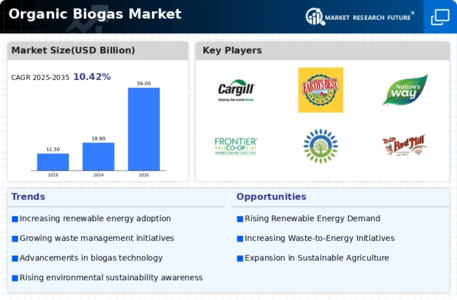Market Growth Projections
The Global Organic Biogas Market Industry is poised for substantial growth, with projections indicating a market value of 18.8 USD Billion in 2024 and an anticipated increase to 56.0 USD Billion by 2035. This remarkable growth trajectory suggests a compound annual growth rate of 10.42% from 2025 to 2035. Such projections highlight the increasing recognition of biogas as a viable energy source and the ongoing investments in biogas infrastructure. The market's expansion is likely to be driven by various factors, including technological advancements, supportive government policies, and rising consumer awareness of sustainability. These dynamics collectively position the organic biogas sector for a promising future.
Government Policies and Incentives
Supportive government policies and incentives are pivotal in shaping the Global Organic Biogas Market Industry. Many countries have established regulatory frameworks that promote biogas production through subsidies, tax breaks, and feed-in tariffs. For example, the European Union has set ambitious renewable energy targets, encouraging member states to invest in biogas infrastructure. These initiatives not only facilitate the growth of biogas projects but also attract private investments. As a result, the market is anticipated to expand significantly, with projections indicating a rise to 56.0 USD Billion by 2035. Such policies are essential for fostering a conducive environment for the organic biogas sector.
Rising Demand for Renewable Energy
The Global Organic Biogas Market Industry is experiencing a surge in demand for renewable energy sources. Governments worldwide are increasingly promoting the use of biogas as a sustainable alternative to fossil fuels. This shift is driven by the need to reduce greenhouse gas emissions and combat climate change. In 2024, the market is projected to reach 18.8 USD Billion, reflecting a growing recognition of biogas as a viable energy source. Countries like Germany and Sweden have implemented policies to incentivize biogas production, further propelling market growth. As the global energy landscape evolves, the demand for organic biogas is likely to continue its upward trajectory.
Diversification of Feedstock Sources
The diversification of feedstock sources is emerging as a key driver in the Global Organic Biogas Market Industry. Traditionally, biogas production has relied on agricultural residues and livestock waste; however, there is a growing trend towards utilizing a broader range of organic materials, including food waste and industrial by-products. This diversification not only enhances the sustainability of biogas production but also increases the overall availability of feedstock. As municipalities and industries seek to manage organic waste more effectively, the potential for biogas production expands. This trend is likely to bolster market growth, as it aligns with global efforts to minimize waste and promote circular economy principles.
Technological Advancements in Biogas Production
Technological innovations are playing a crucial role in enhancing the efficiency of biogas production processes within the Global Organic Biogas Market Industry. Advanced anaerobic digestion technologies, such as multi-stage digestion and co-digestion, are being adopted to optimize biogas yields from organic waste. These advancements not only improve the economic viability of biogas plants but also reduce operational costs. For instance, the implementation of real-time monitoring systems allows for better management of biogas production, ensuring optimal conditions for microbial activity. As these technologies become more accessible, they are expected to drive market growth significantly, positioning biogas as a competitive energy source.
Increasing Awareness of Environmental Sustainability
There is a growing awareness of environmental sustainability among consumers and businesses, which is influencing the Global Organic Biogas Market Industry. This shift in perception is leading to increased demand for sustainable energy solutions, including biogas. Organizations are recognizing the benefits of utilizing organic waste for energy production, which not only reduces landfill waste but also lowers carbon footprints. As more companies commit to sustainability goals, the adoption of biogas as a renewable energy source is likely to rise. This trend is expected to contribute to a compound annual growth rate of 10.42% from 2025 to 2035, underscoring the market's potential for growth.




















Leave a Comment